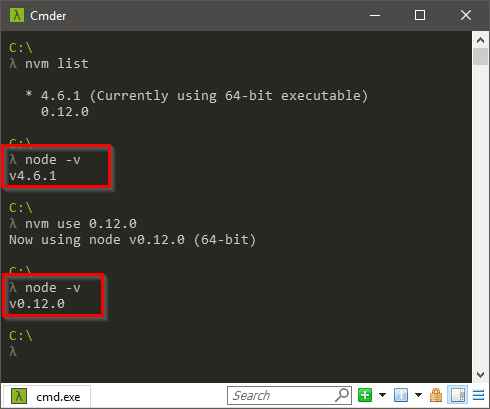
You can display all of the new and old aliases with the nvm ls command. The following example defines a new maintenance alias as Node version 13.10.1. Use the nvm alias command to create a new alias. NVM confirms the new value for the alias. Follow the alias keyword with the default alias and the new version of Node it should reference. Use the nvm alias command to change the default Node version. But you can use the alias command to change the value of an existing alias or create a brand-new alias. NVM already provides some pre-made defaults such as default and node, which refers to the latest version. You might find it convenient to refer to a Node version by a different or easier to remember name. NVM confirms it is now running the selected version of Node and returns a Node prompt. The run command is very similar to nvm use in all other respects. To switch to a new version of Node and immediately open a Node console, use nvm run. To go back to using the system’s version of Node, run the command nvm use system. You can also confirm the version of Node currently in use with node -v. NVM again returns the current version number. Now using node v14.15.4You can also confirm the current version of Node with nvm current. NVM confirms it is now using the new version. Specify either the version number of Node (major or minor release) or an alias such as node. To select a different version of Node, use the nvm use command. NVM returns a list of all Node versions and aliases, along with an arrow indicating the current version. Review all installed versions of Node with the ls command. If you specify a version of Node that is not available, NVM responds with the error message Version '15.0.2' not found - try 'nvm ls-remote' to browse available versions. Node also displays the exact version it selected after installation (for example, Now using node v14.15.4). You can determine the latest version of each release from the output of nvm ls-remote. If you only specify the major release number for a Node version, NVM installs the latest version of that release. Now using node v15.5.1 (npm v7.3.0)Ĭreating default alias: default -> node (-> v15.5.1) Note
NVM INSTALL NODE LATEST INSTALL
To install the current version of Node, run the following: nvm install nodeĪfter a successful install, NVM displays information about the installation. You can install as many versions of Node as you want. The install command downloads, compiles, and installs the specified version of Node. You can confirm the version of NVM that is running with the following command: nvm -version If you see the message nvm: command not found, confirm the original installation completed successfully and repeat step #2 of this section to source the. If the installation was successful, NVM returns nvm. nvmrc file (if used).Ĭonfirm you have successfully installed NVM.


NVM_INC: The directory for Node’s include files (for building C/C++ add-ons).NVM_BIN: The location where Node, the Node Package Manager (NPM), and global packages for the active version of Node are installed.Use caution if you decide to change them for any reason. We recommend leaving them at the default settings.

NVM uses the following environmental variables. To install NVM using wget, run the following command: wget -qO- | bash

To install NVM using curl, run the following command: curl -o- | bash We recommend you install Node using either curl or wget. NVM alters path variables to select different versions of Node, so it works with pre-existing installations. You can install and use NVM regardless of whether you have installed Node already. bashrc directives might vary slightly on different shells. These instructions are generally valid for most Linux distributions, although some of the. A Summary of the NVM Installation and Configuration ProcessĪ complete NVM installation consists of the following high-level steps. NVM also simplifies the installation and compilation process because Node versions no longer have to be obtained directly from the distribution channel. NVM stores the Node versions and associated modules inside your user directory, so sudo does not have to be used. Since NVM enables quick and effortless switching between Node versions, it is much easier to test version compatibility and upgrades with multiple libraries. Node changes quickly, and testing applications with different versions is often difficult.
NVM INSTALL NODE LATEST HOW TO
This guide describes how to install NVM, and how to use it to install and run different versions of Node. NVM allows you to easily install different versions of Node and switch between them on a per-shell basis. NVM is easy to install and understand, and works on any POSIX-compliant shell (for example, sh or bash). Node Version Manager (NVM) is an open source version manager for


 0 kommentar(er)
0 kommentar(er)
